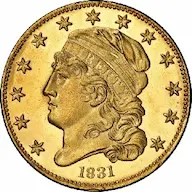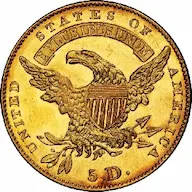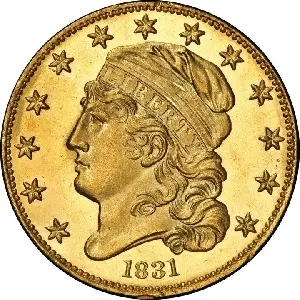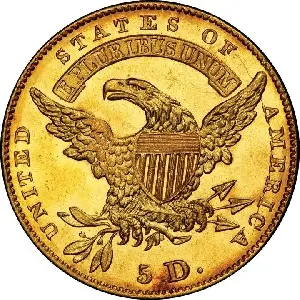1831 Capped Head $5 Half Eagle, Large 5D
The story of the 1831 Capped Head Large 5D $5 half eagle closely parallels that of 1831 Small 5D half eagle.
Despite an ample mintage of 140,594 pieces, only about 30 examples of the 1831 Large 5D half eagle are known today.(1) The Small 5D variety has fared even worse, with no more than 20 extant specimens.(2)
Like nearly all its Capped Head brethren, the 1831 half eagles fell victim to international bullion profiteers.(3)
The bimetallic standard set by the Mint Act of 1792 mandated a 15:1 ratio of silver to gold, and did not allow any flexibility in reaction to the fluctuating ratio on the world stage. Vast discoveries of silver and war eventually pushed this ratio in Europe to 16:1 or more.
In the United States, where the ratio remained frozen at 15:1, speculators realized U.S. gold coins were worth more than their face value in silver on the international market.
If an individual showed up at the U.S. Mint in Philadelphia requesting a metals exchange, for every 15 ounces of his silver the Mint would trade him one ounce of gold (in the form of coinage). In Paris or London, that gold ounce would bring 16 ounces of silver. The same speculator would then return to Philadelphia with 16 ounces of silver, stick one ounce in his pocket, and as before, trade 15 silver ounces for one ounce of gold, and the process repeated itself.
This cycle played out on a very large scale until there were no U.S. gold coins available. Especially hard hit were the Capped Head half eagles of 1813-1834. Not many of them ever saw circulation. Of the cumulative Capped Head half eagle mintage of 1.39 million, about 99.9% of them perished in the melting pot.(4)
Congress finally remedied this problem with the Coinage Act of 1834, which reduced the gold weight in U.S. coinage, thus eliminating the profitability of selling overseas.(5)
The Capped Head half eagles are one of the most challenging coin sets to collect in United States numismatics. Both 1831 varieties and many of the dates belonging to this group possess extraordinary and sustained price increase records, powered by their extreme rarity and high demand.
Unfortunately, the Capped Head half eagles are well beyond the reach of average collectors. For those few buyers able to claim ownership of one of these historic rarities, congratulations! Your numismatic knowledge and foresight will someday reward you or your heirs.
| Estimated survivors in all grades: 30 ?
The survivor estimate from researcher John Dannreuther. |
| PCGS Rarity Scale: 8.9 ?
The 'PCGS CoinFacts Rarity Scale' assesses the relative rarity of all U.S. coins, based on estimated surviving examples. The scale runs from 1.0 to 10.0. The higher the number, the rarer the coin.
Learn more at PCGS. |
| Search for the 1831 Capped Head $5 Half Eagle, Large 5D on eBay** |
Preview of eBay selection(good luck finding this rarity for sale -- but check back now and then):
 |
 |
| Trendline Avg = 20.83 | BETTER |
 |
 |
| Trendline Avg = 20.83 | BETTER |
Historic Value Trend Charts:
| Last updated 8-11-25 | Return to Key Date Coin List | |
| Compare to Common Date Coin of Same Type | ||
|
|
||
| Download Charts to Your Computer | ||
Sources
1. Stack's Bower Galleries. 1831 Capped Head Half Eagle. Large D. Oct 2015 Auction.
2. Heritage Auctions. 1831 $5 Large 5D. Aug 2020 Auction.
3. NGC. Capped Bust $5 (1807-1834).
4. PCGS. Capped Bust $5.
5. NGC. Capped Bust $5 (1807-1834).
**Many very fine coin dealers sell on eBay. At any point in time, there may be over one million search results for United States coins. This includes quite a few of the recommendations on our Key Date Coin List.
If you’re thinking about purchasing a rare coin, eBay is certainly worth a look. For your convenience, the links from this site to eBay are coded to bring up only coins certified by PCGS and NGC.
As is always, always the case, never buy a valuable coin from a seller whose trustworthiness cannot be verified. Learn more about this at our chapter Best Places to Buy Coins, which also has a section on doing business on eBay.
In the interest of full disclosure, Rare Coins 101 receives a small commission anytime someone connects to eBay from this site and purchases something.
Coin images by Stack's Bowers Galleries.


